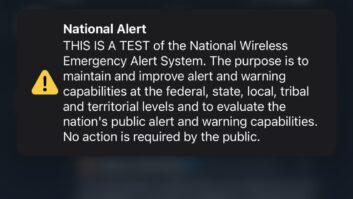It was a banner day for the FCC, which also moved forward on EAS.
The commission adopted an order that requires EAS participants to accept messages using Common Alerting Protocol after FEMA adopts standards.
NAB applauded the efforts “including much-needed outreach with state and local officials to ensure a robust EAS system.”
As we’ve reported, CAP involves the transmission of EAS alerts as text, audio and video via broadcast, cable, satellite, and other networks.
The FCC says using this will make it easier for the disabled and non-English speakers to receive alerts. The commission seeks comment on how best to deliver EAS alerts as well as broader emergency and public safety information to these groups, and commits to adoption of a final order within six months.
The agency also seeks input on how EAS is (or is not) working and whether additional testing, station certification and assessments of how well the system works after an EAS warning has been triggered.
The agency left open the issues raised in a petition filed by several groups representing non-English speaking persons and directed its Public Safety and Homeland Security Bureau to meet as soon as possible on providing emergency information to non-English speakers.









